Content
- 1 Basic rules for growing a rose from a cutting
- 2 How to care for
- 3 Autumn cuttings of roses - advantages and terms
- 4 How to cut rose cuttings
- 5 Planting a rose from a cut
- 6 Roses from cuttings at home
- 7 How to keep rose cuttings in winter
- 8 How to root a rose from a bouquet
- 9 Rooting cuttings of roses in potatoes
- 10 How to choose roses for a summer residence?
- 11 Preparing cuttings for planting
- 12 How to grow beautiful roses from a cutting
- 13 How to care for planted roses?
As a rule, autumn pruning of garden roses in central Russia, and even more so to the north, is inevitable. Sometimes climbing roses have to be cut rather shortly. There are a lot of great cuttings left! What to do with such wealth? I tried many methods: I dug them in, after wrapping them in linen, and hid them in the cellar, and grew them in a room on the windowsill, until spring. I could not boast of the results. And for the last two years I have been using my own method, in which cuttings survive by 70-80%. I would be glad if someone will find it useful.
Root cuttings
This method is good both for urban residents who have a loggia and a balcony in the apartment, and for those who live in their own houses outside the city and have a covered terrace. This is what it is about. Having pruned the roses in early November, after the first light frosts, I cut cuttings with 2-3 buds about 20 cm long.I take a plastic bucket and fill it first with expanded clay, the layer of which should not be less than 6 cm, and then with earth for roses, this is very good mix the earth with Perlite or Vermiculite. Or make the composition of the earth traditional, suitable for roses with the addition of sand. But I will say right away that for my method, sand is still less preferable. It is better to buy earth "For roses", plus those additives which I mentioned above.
For those who do not know what Perlite is, let me explain - it is a natural material, volcanic glass. It is mainly used for growing indoor plants, as it improves the quality of the soil, making it lighter and more breathable. Perlite holds water almost 5 times its own weight, so for indoor flowers it can be added up to 30% by volume. For our cuttings, 20% is enough. Chemically inert. The soil with the addition of Perlite will have remarkable properties, namely, the roots develop well in plants, they will grow healthier and they can be watered less often. Vermiculite has similar properties. They are often sold in flower shops, at flower trade shows.
But back to our cuttings. I slightly moisten the prepared earth. Precisely slightly! Then I take the cuttings, dip the lower end in water, and then in Kornevin powder and stick it into a hole made in advance with a stick in the ground. And so all the cuttings. A bucket with a diameter of 30-40 cm can hold up to 30 or more cuttings. It would be good to “solder” the top of the cuttings with paraffin by melting a small candle stub in a water bath. For the most meticulous gardeners, I recommend immediately attaching tags with the name of the varieties. White plastic dairy bottles and a marker are suitable for this.
Rooting cuttings of roses
When the cuttings are planted, I take hard cellophane, the sheets can be purchased at flower shops or, worse, a plastic bag. The fact is that cellophane transmits light better! I wrap the bucket with it, tie the rope tightly around it so that it holds, it turns out to be a pipe. I fix the top of this “pipe” with clothespins.I wrap the whole bucket, you can use old bike blankets, a quilted jacket and so on (now it is clear why a bucket is preferable to a plastic one - the metal freezes very much), and I put it on a glazed, but not heated balcony, in the warmest but lightest corner.
If the floor on the balcony is cement, it is necessary to substitute foam plastic or boards under the bucket! I water it very rarely, and in cold weather I don't water it at all. In the bright January sun, you can let the cuttings breathe, freeing the top of the “pipe” from the clothespins and spray a little with water with the addition of Epin, instead of watering, and close only when the water has completely evaporated. All this must be done in the morning. In severe night frosts (-25 .. -30 ° C), the entire structure, together with a cellophane pipe, must be covered with something warm, or surrounded by a bucket with hot water bottles, or brought into the room. Frost is not so terrible for adult roses, but we are talking about cuttings!
Rooted stalk of a rose with blossoming buds
It may seem to someone that there is too much fuss, but believe me - this is not so, indoor flowers require much more attention. And most importantly, in the spring we will have good seedlings. We take the cuttings from the bucket carefully, with a tablespoon, and not with a scoop! We plant in holes prepared (using the traditional method for roses). I recommend in May, nevertheless, after planting in the garden, hold the cuttings under the jar, gradually opening them, and finally open them after the threat of recurrent frosts. And one more thing: in May there is a very bright sun, which is just as destructive for the surviving cuttings, therefore it is necessary to shade them during the day - spruce branches, branches or thin lutrasil. And of course, do not forget to spray with water with the addition of stimulants.
Wish you luck!
Rose is undoubtedly one of the most popular ornamental flowering plants that almost any grower would like to grow at home. Today there are a huge number of different varieties, each of which is charming in its own way. Each type of rose has its own characteristic features. Many growers from buying a rose seedling are stopped by its rather high cost, as well as uncertainty about the quality of the planting material. However, there is still a way out of such a difficult situation. At home, it is quite possible to grow a rose from a cuttings taken from a garden plant in the fall. But in order for the rose to take root, as well as to grow and develop normally, you should know several important nuances.
Basic rules for growing a rose from a cutting
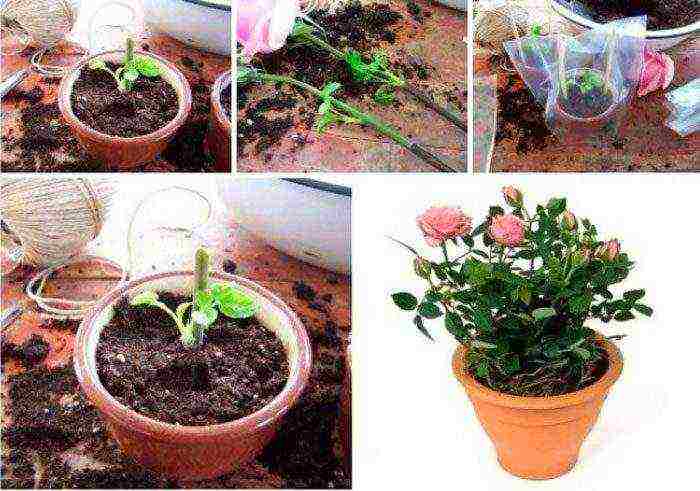
In order to get a beautiful and strong plant without much hassle, such a propagation method as cuttings is excellent. Such a plant will not have root growth, which will greatly facilitate caring for it. And this method of reproduction will save the grower from many problems associated with the acquisition of planting material. And that's all, because plants purchased in the store can also be propagated in this way.
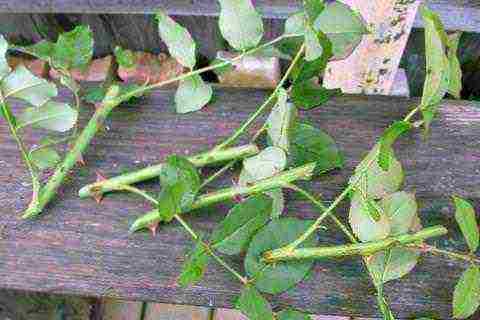
The first thing to do is to prepare the cuttings themselves. For the cutting, you should choose a shoot that has at least 5 leaves, in this case it will give roots much better than those trimmed stems that have only 2 leaves. Also, these cuttings are grafted several times better. The cut must be done very carefully, and it must be oblique. Cut off the shoot a few centimeters from the buds. After that, it is necessary to carefully cut off all the leaf plates located below from the handle. Shoots of medium thickness are excellent for cuttings, and it is not recommended to use thick or thin stems for such purposes.

Experienced growers do not recommend propagating imported roses by cuttings, the fact is that such cuttings rarely root normally. A plant that grows in the area where you yourself live is best suited for this procedure. It is also very important to consider that the cuttings must be fresh.
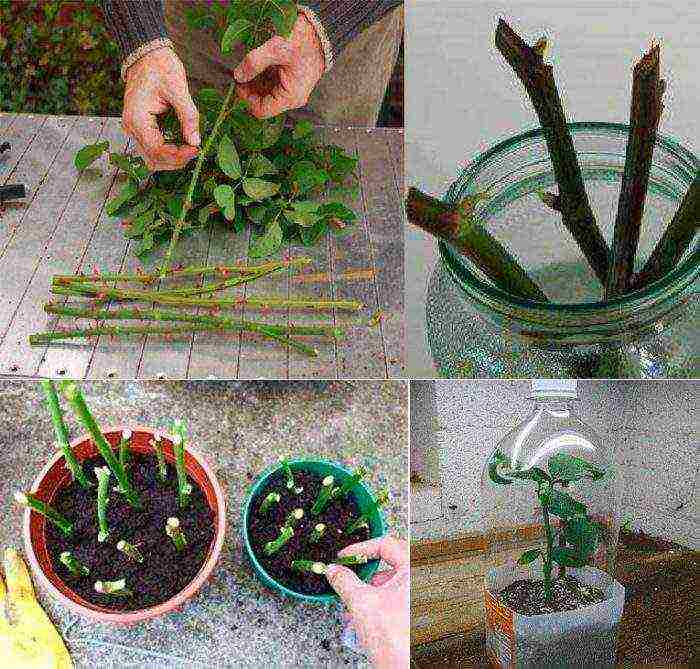
The whole process of grafting is divided into 4 stages:
- Fill a small container with a weak potassium permanganate solution. Then the cut cutting should be placed in it and left there for the whole day.
- Then the cutting is planted at a relatively shallow depth. So, 1 kidney should be in the soil, and the second one should rise above its surface.
- In order for rooting to be successful, you can make a mini-greenhouse from a film, and a cap is perfect for this purpose.
- The seedling should be given the necessary care. It needs to be watered and ventilated on time. After rooting, it is transplanted into a permanent pot.
In the event that you do everything right, then after some time a strong root system will grow at the cutting, and in just 2 years you will be able to fully enjoy the beauty of the rose that you yourself have grown at home. In order for a young plant to grow and develop well, as well as to be strong and healthy, it is imperative to remove all buds that form in the first 2 years of life. At the same time, one should not feel sorry for them. The fact is that the plant spends too much effort on the formation of buds, as well as on their growth and development.
How to care for
It is recommended to propagate the rose by cuttings in the second half of the autumn period. In order for the stalk not to die and take root quickly enough, the most comfortable conditions should be created for it.
Selection and preparation of soil mixture
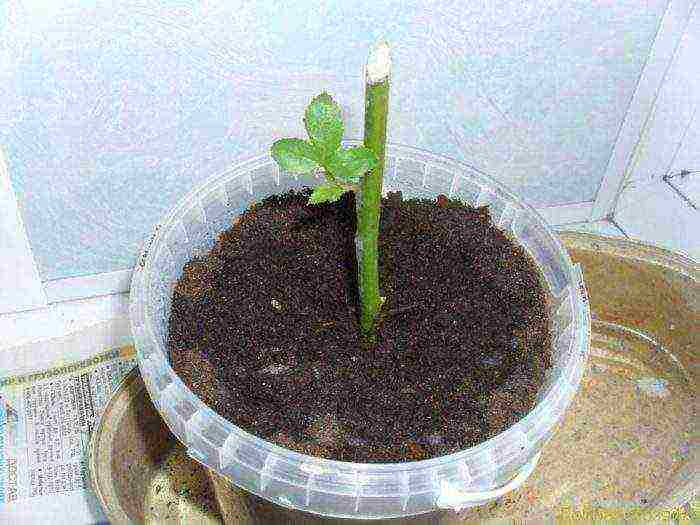
To grow a rose from a cuttings at home, you need to use a suitable soil. So, for normal growth and development, such a plant needs a soil mixture saturated with nutrients. This soil can be purchased at any specialty store. However, if you wish, you can prepare this soil mixture with your own hands. So, for this you need to combine clay, sand, and humus. Some growers with considerable experience behind them advise adding a small amount of chicken droppings to such a mixture, but this can be omitted. A fairly loose substrate is also a prerequisite for the normal rooting of a rose cut. In this case, young roots can easily grow deeper into the container.
Basic rules for watering
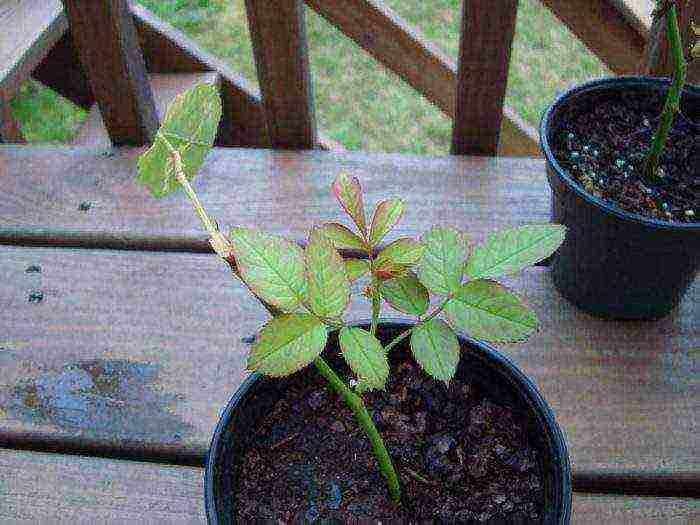
If you are going to grow such a rose indoors, you should definitely remember that it reacts extremely negatively to both extreme cold and excessive heat. In this regard, experienced flower growers advise in winter to place such a plant in close proximity to heating devices or batteries. In the summer, it is better to transfer this plant to a place where relative coolness will remain during the day. So, a balcony is perfect for this. It should also be remembered that all types of roses respond positively to high humidity. In this regard, it is recommended to systematically moisturize the plant from the sprayer.
Required lighting level

This plant reacts extremely negatively to exposure to direct sunlight. The fact is that they are capable of damaging foliage, leaving burns on its surface. To place such a flower, it is recommended to choose a sufficiently dark place. If there is no such place, then the plant must be shaded from the direct rays of the sun. In this case, it should be remembered that in no case should you place a rose in the back of the room. The fact is that poor lighting will negatively affect not only the growth and development of the flower, but also its decorative effect.
After the planted stalk gives roots, gets stronger and starts to grow, you can begin to accustom it to fresh air. But it should be borne in mind that this should be done gradually. So, for this you need to open the package daily for some time. Such a plant can be transplanted into open ground in the warm season. However, this procedure must be approached with full responsibility.It should be remembered that on the first day after the transplant, such a rose must be well moistened. Please note that the soil after watering should not be wet, since in this case rot can develop on the roots rather quickly and the flower will die. We must try to keep the substrate constantly slightly moistened; for this, the flower needs to be watered quite often, but at the same time not use a very large volume of water. Do not forget to systematically feed the rose, both mineral and organic fertilizers are excellent for this.
Is it possible to grow roses from cuttings in the fall? On this account, the opinions of florists differ, however, autumn breeding is often preferable and leads to better results than spring breeding.
Rose is the real queen of the garden, whose fragrant buds attract admiring glances all summer long. Every summer resident is ready to take care of roses all year round, if only they are the most beautiful, healthy and willingly bloom.
One of the most popular propagation methods for this beautiful flower is growing a rose from a cuttings. Autumn is the most suitable period for growing roses, and besides, this activity will not take you much time. Let's find out how to plant a rose from a cutting.
Autumn cuttings of roses - advantages and terms
Unlike vaccinations roses, cuttings have a number of advantages:
- plants grown in this way do not form wild root shoots, which simplifies their care;
- roses from cuttings tolerate winter better and even when the aerial part freezes out, they are restored from dormant buds;
- it is easy to get planting material - you can take a stalk from any rose from the presented bouquet.
Cutting roses in the fall coincides with the time of their autumn pruning. This usually happens in late October - early November.
What are the best roses to grow from a cuttings:
- all varieties of polyanthus and miniature roses;
- most semi-growing roses;
- climbing roses from the rambler group (Rambler);
- Excelsa roses;
- large-flowered variety Flammentanz;
- Iceberg and Rosalind varieties from the floribunda group;
- hybrid tea (not to be confused with tea) roses take root rather quickly, but subsequently their root system develops poorly, so it is better to graft them.
The most difficult thing is to cut repair and park roses.
How to cut rose cuttings
Roses are cut as follows:
- choose healthy, mature shoots 4-5 mm thick;
- cut them into small pieces (each of them should have 3-5 developed buds);
- make the cuts in the upper part straight, and in the lower part - obliquely, so that later you do not get confused in which part to plant the cutting;
- carry out all sections using a sharpened tool, treating it with alcohol and rinsing with boiling water;
- make the upper cut 2-3 cm above the upper kidney, and the lower one - right under the lower kidney;
- if you are rooting a rose stalk at once, do not cut off all the leaves, leave a few to provide the plant with nutrition. Remove the lower leaves completely.
Planting a rose from a cutting
As a rule, the autumn cutting ends with the planting of the cuttings in a permanent place. This method is preferable already because the plant experiences less stress and takes root better in a new place. General rules autumn rooting of rose cuttings look like this:
- cut the cuttings and treat them with a root former (for example, Heteroauxin);
- dig a hole about 30 cm deep, fill 2/3 with grass and sprinkle with compost;
- plant shoots at an angle of 45 degrees, leaving about 1/3 of the cuttings above the ground or 1-2 buds above the ground;
- spill them abundantly with water.
Many growers do not know how to cover the cuttings of roses for the winter so that they will survive safely until spring. Everything is very simple.Take a plastic or glass container and punch several holes in it for air circulation, or raise it above ground level. Sprinkle the bottle with foliage and cover with a non-woven material, and mark the landing site with pegs. You can also insulate the planting site with straw.
Roses from cuttings at home
The described method is suitable both for residents of city apartments and for owners of closed terraces in summer cottages. It consists in the following:
- in early November, after the first light frosts, prepare cuttings with 2-3 buds about 20 cm long;
- so that the buds do not bloom ahead of time, quickly dip the tops of the cuttings in melted wax, and then immediately in cold water;
- take a plastic bucket or other container and fill it with a layer of expanded clay 5-6 cm thick and earth for roses mixed with perlite or vermiculite;
- slightly moisten the soil in the container, dip the lower end of the cutting into water, and then into the Kornevin preparation and stick the cutting into the prepared hole (about 30 cuttings are placed in a bucket with a diameter of 30-40 cm);
- wrap containers with cuttings in thick cellophane or a plastic bag and tie with a string. Fasten the top of the bag with clothespins. Or use glass jars (but don't leave the planting in the sun);
- wrap the container with a blanket and put it on the glassed-in balcony in a warm and bright place;
- if the floor on the balcony is cement, the container must be installed on boards or foam;
- in severe night frosts, remove the cuttings indoors.
How to keep rose cuttings in winter
If you decide to postpone growing roses until spring, it's time to take care of the safety of the cuttings in the winter. This can be done as follows:
- Dig a 15 cm deep hole in the garden, cover the bottom with a covering material (cotton cloth) and place the cuttings there. Mark the edges of the hole with pegs so that in the spring it is easier to find the shoots stored in storage;
- remove the leaves and place the cuttings at the same distance from each other;
- cover the cuttings with the remaining cloth and sprinkle with earth;
- in the spring, after the snow melts, dig up the cuttings and inspect them. Callus is formed on "established" cuttings - a thick growth on which roots are formed;
- after extraction, it is advisable to immediately plant the cuttings in the cuttings or in a permanent place;
- if planting is postponed for a day or more, place the cuttings in a container of water (it is recommended to add a few drops of Epin to it).
How to root a rose from a bouquet
Looking at a beautiful presented bouquet of roses, I want the flowers to remain the same fresh and bright for a long time. Of course, it will not be possible to prolong the "blooming" of cut roses. But you can try to grow a "new bouquet" of them. For this, the stems of flowers must be cut into cuttings. They can be rooted at any time of the year in flower pots or other containers. For these purposes, you can also use cellophane bags, filling them with chopped moss or fibrous peat. Then moisten the filler with a special solution - 1 tsp. aloe juice for 9 tsp water. Inflate the bags slightly, tie them up and hang them from the window frame. In an environment with high humidity, a greenhouse effect will occur, and roots will begin to form in the cuttings. Potted soil should be watered periodically. New shoots and leaves that will form on them should be cut in half so that the plant saves its energy until it is planted in the ground in the spring.
Rooting cuttings of roses in potatoes
You can also grow a rose with potatoes. Treat a freshly cut cutting with potassium permanganate and leave it in a solution of aloe juice with water (in a 1: 1 ratio) for 12 hours. After that, insert the rose into the potato tuber, from which all the eyes have been removed, place this "composition" in the pot, cover 2/3 with earth and pour with a dark pink solution of potassium permanganate.Subsequently, water the plant with settled water as the topsoil dries up, and once every 5 days with sweetened water (2 tsp sugar per 1 glass of water). Cover the stalk with a jar to create a greenhouse effect and encourage root formation.
Now you have learned all about how to plant roses with cuttings in the fall. As a rule, the plants planted at this time take root well, take root and must bloom in the future.
The most chic, sophisticated and eye-catching plant in the flowerbed of any summer cottage is a rose. This flower, in addition to nobility and beauty, will give your plot in the country an incredible smell. However, not every rose is suitable for growing at home without the use of special technologies.
How to choose roses for a summer residence?
In order to grow a beautiful healthy plant, you need to pay attention that it is easier to grow a domestic rose from a cuttings than, for example, a Dutch one. Then there are a few more factors to consider.
First of all, we pay attention to how much space is planned to be planted with roses on the site. If the site is large enough, then bush and climbing varieties of roses will look very beautiful and advantageous. Such plants grow about one and a half meters in height. They often need provide support... In terms of humidity, roses that are more resistant to weather and rain are best suited for areas with high humidity.
For dry climates, roses of varieties from French nurseries are suitable.
Among other things, you should pay attention to the number of thorns, which is different for different varieties of roses, as well as to the frost resistance of the plant.
There are three ways to grow roses:
- vegetative (cuttings),
- with the help of seeds,
- by dividing the plant (replanting, layering, etc.).
The cherenkovo method of growing a rose for a summer residence is not at all a difficult process, you just need to know a few nuances that are the key to a successful result.
Preparing cuttings for planting
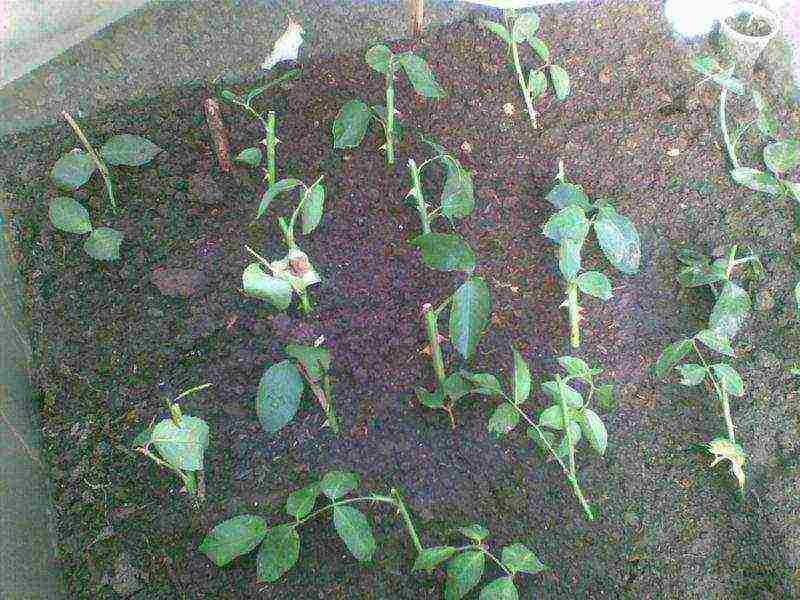 Before proceeding with planting, it is necessary, first of all, to prepare the cuttings for this. The most favorable option for cutting a rose is considered when the rose has spent one year in a greenhouse. For a successful grafting process, the cuttings must be of the correct length and thickness. Cutting can be obtained by cutting off the longest branch from this year's escape.
Before proceeding with planting, it is necessary, first of all, to prepare the cuttings for this. The most favorable option for cutting a rose is considered when the rose has spent one year in a greenhouse. For a successful grafting process, the cuttings must be of the correct length and thickness. Cutting can be obtained by cutting off the longest branch from this year's escape.
In general, for this method of growing roses, you can use both lignified cuttings (i.e., last year) and semi-lignified (i.e., this year). Both are used to grow roses, but the already lignified cuttings are harvested in late autumn, after which they are placed in sphagnum or peat and stored in the refrigerator throughout the winter. During this period, callus is formed on the cuttings, and then the roots. They are planted in early spring.
Most effective it turned out to be the planting of semi-lignified cuttings, which are obtained from the shoots of the current year. The most suitable period for cutting off a shoot is the beginning of flowering.
To cut such cuttings, you need to know that at the beginning of each of them there must be a stem node. It is located in the place from which the leaf of the plant departs and is a thickened section of it. First, cut the stem under the bottom leaf, then under the next top leaf. We remove all leaves from the stem, except for the two upper leaves, due to which photosynthesis occurs in the stem during the growth of roots from the point of cutting of the lower leaves. It is also necessary to cut off all the thorns.
There are several ways and methods of cutting roses, which today are quite simple for any gardener, including an amateur. The simplest and at the same time effective method is grafting by rooting cuttings with three buds and then planting them in the ground.
In order to properly root the stalk, it should be about 10-15 cm long.
We plant the prepared stalk in the soil at an angle. Planting is carried out either in a special bed or in pots, into which we add peat and sphagnum. They create fertile soil. Next, cover the future plant with a jar or plastic bag in order to create a small greenhouse.
After a few weeks, if new roots are already beginning to break through, then you can transplant the cutting into a pot. At the same time, he no longer needs a greenhouse. Also, the prepared cutting can be planted not only in the soil, but also in the water. Already after weeks 3-4 they will take root and can be planted in the ground. Throughout the entire period, you need to constantly add water and change it.
In order to achieve the maximum effect when planting roses, you can place them in the purchased solution. heteroauxin, which today can be purchased without any problems. This drug is a root growth stimulant. With its help, the roots of the plant will grow much faster and at minimal cost.
How to grow beautiful roses from a cutting
Growing in autumn
 If you got an unusual rose variety in the fall, then in order to grow it, you just need to dig the stalk of such a rose into the ground and cover dry shelter, which will help the plant to overcome the winter and not die in severe frosts. It is with the help of this method that you will be able to make sure that the cuttings remain alive until spring and grow gorgeous roses from them.
If you got an unusual rose variety in the fall, then in order to grow it, you just need to dig the stalk of such a rose into the ground and cover dry shelter, which will help the plant to overcome the winter and not die in severe frosts. It is with the help of this method that you will be able to make sure that the cuttings remain alive until spring and grow gorgeous roses from them.
Growing cuttings of roses in potatoes
You can also grow cuttings using potatoes. To do this, when preparing the cutting, it should be treated with potassium permanganate, then left in aloe juice solution for 12 hours, then insert the lower end of the cutting into the potato, from which all the eyes were previously cut out.
We send potatoes together with their stalks to dark pots. First watering we carry out a strong solution of pink potassium permanganate. This method is one of the most popular, since in the process of such growing of a rose, the potato creates a moist environment for the roots of the cuttings, which allows it to grow quickly enough.
You can cover these cuttings with a jar to create a greenhouse for them. They should be watered every five days sweet water. After a while, you need to start accustoming the cuttings of roses to normal environmental conditions by raising the jars for a certain period of time. And after a few more weeks, and completely remove the banks.
Watch a video about growing roses from cuttings.
Growing roses from a bouquet
 Quite often, looking at the presented bouquet of roses, we really want to grow the same rose on our own. This is more real than it might seem, since you can also grow a rose yourself from a bouquet using cuttings. The only thing is that not every variety of roses can take root. For example, the Dutch rose is much more difficult to take root than the domestic one. Domestic roses take root better, while imported roses are better not to be cut by cuttings, since they are treated with preservatives before shipment.
Quite often, looking at the presented bouquet of roses, we really want to grow the same rose on our own. This is more real than it might seem, since you can also grow a rose yourself from a bouquet using cuttings. The only thing is that not every variety of roses can take root. For example, the Dutch rose is much more difficult to take root than the domestic one. Domestic roses take root better, while imported roses are better not to be cut by cuttings, since they are treated with preservatives before shipment.
It is best to subject the donated flowers to cuttings immediately so that they do not stand in the vase. We remove thorns and buds from each rose, cut off cuttings 15-30 centimeters long, remove the lower leaves completely, and the upper ones by a third. Then, just as in the previously described method, we put it in water until the cuttings take root, after which we transplant them into pots and build a greenhouse.
If you want the bouquet of the presented roses to stand a little and please the eye with a beautiful color, then do not forget change water every day... We put flowers in a bucket of water every night. As soon as the flower begins to shed its petals, we carry out cuttings.
After the cutting has been transplanted into a pot of soil and covered with a jar, it must be closely monitored at all times. During the growth of the cutting, create a small gap between the jar and the ground.Gradually, carefully increase it so that the plant gets used to the new environment.
The main method by which the growing rose is taken care of is the removal of discarded buds and flowers. This will not allow the plant to spray its forces for flowering, but will allow it to grow faster.
How to care for planted roses?
 One of the important aspects of caring for a planted cuttings is proper watering. In order not to rot the roots, you should not water the cuttings constantly, you need to give them the front between waterings. Also, the roots will be able to access oxygen in this way. At the same time, roses love sufficiently moist soil and require constant replenishment with fertilizer substances. The correct irrigation technique will ensure the development of the correct root system.
One of the important aspects of caring for a planted cuttings is proper watering. In order not to rot the roots, you should not water the cuttings constantly, you need to give them the front between waterings. Also, the roots will be able to access oxygen in this way. At the same time, roses love sufficiently moist soil and require constant replenishment with fertilizer substances. The correct irrigation technique will ensure the development of the correct root system.
When the stalk reaches a height of 15-20 centimeters, it can be fertilized with nutrients. The rose will answer you with gratitude and will bloom more abundantly and brighter with high-quality and timely care.
In addition to watering, roses should be pruned. Remove the buds after each flowering.
This is a kind of sign for the plant so that it can bloom again. Removing those areas that have signs of the disease is a prerequisite for keeping the rose in a healthy state. This minimizes the risk of spreading the disease to the entire plant area.


